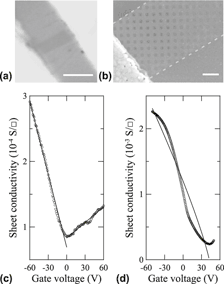Article contents
Electron transport properties of graphene with charged impurities and vacancy defects
Published online by Cambridge University Press: 26 March 2013
Abstract

Nano-structured graphene has recently attracted extraordinary attention due to its potential use as an electronic or spintronic material. We investigated the electrical conductivities of antidot and Ar-sputtered graphene samples under a magnetic field in terms of the carrier density. Antidot samples exhibit conductivity that is well explained by charged impurity scattering, which is associated with intravalley scattering. This suggestion is supported by the low intensity of the Raman D band, which is related to intervalley scattering induced by structural defects. In contrast, Ar-sputtered samples show a strong D band and conductivity that is affected by defect scattering. The difference in the main scattering mechanism between the two types of samples appears as Shubnikov-de Haas oscillations at high magnetic fields, which are observed in antidot samples but not in Ar-sputtered samples. Furthermore, an analysis of weak localization effects in both samples at low fields reveals that intra- and intervalley scatterings play significant roles in antidot and Ar-sputtered samples, respectively.
- Type
- Articles
- Information
- Copyright
- Copyright © Materials Research Society 2013
References
REFERENCES
- 8
- Cited by


